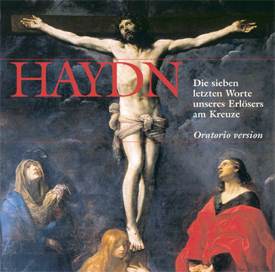The original version of Haydn’s ‘The Seven Last Words
of Christ on the Cross’ was written as a group of seven orchestral pieces
(Sonatas), each lasting about 10 minutes, interspersed with homilies.
Each homily considered one of Christ’s last seven words and the following
Sonata illustrated it, the whole was preceded by an orchestral introduction
and concluded with an orchestral postlude depicting the earthquake.
To make the pieces more accessible Haydn later arranged them for string
quartet. It is in this form that they are most common on CD, with the
original orchestral form being very rare indeed. In both cases, Haydn
never intended the Sonatas to be played without a break, 7 adagios in
a row was certainly no way to create a structural whole. When the string
quartet version was first performed, the words from the Scriptures were
provided in printed form with a break between each movement to allow
the listeners to meditate on Christ’s words.
Perhaps it was inevitable that someone should provide
the orchestral version with words. Haydn heard one such attempt, which
used scripture and religious poetry. He was sufficiently impressed to
have Baron von Swieten re-work the text and he created his own vocal
lines. This choral version of the ‘Seven Last Words’ follows the orchestral
version directly, except for a new orchestral interlude after the 4th
Sonata. This lovely interlude has the distinction of being one of the
first classical orchestral uses of the Contra-Bassoon. Amongst Haydn’s
oratorio works, ‘The Creation’ and ‘The Seasons’ outrank ‘Seven Last
Words’ in popularity, which is not surprising as the work is a very
sober one, a long meditation with little scope for contrast. So it is
all the more welcome to have this new recording.
It is an ideal work for CD, (lasting 60 to 70 minutes)
and the catalogue is not over stuffed with other versions. The most
notable recent recording was Harnoncourt’s fine version with Concentus
Musicus Wien and the Arnold Schoenberg Chamber Choir and it is against
this recording that any newcomer must inevitably be measured.
The Nordic Chamber Choir are a choir of 18 young singers.
The choir, under its musical director, Nicol Matt, has a very fine and
varied discography. They are accompanied here by the Kurpfälzisches
Kammerorchester, a Mannheim based chamber orchestra who have specialised
in the performance of the 18th century Mannheim school of
composers. The orchestra has a core group of 14 to 15 players, on this
recording the ensemble is based around a group of 14 string players,
so with the addition of wind players the entire orchestra barely tops
30 players. They make a very stylishly lean, mean sound which ideally
complements the bright sound of the young chamber choir. The woodwind
have one or two moments of sour tuning, it is a pity that some extra
session time could not have been found to correct them.
The conductor, Nicol Matt favours quite swift tempi,
which is no bad thing in this sober work. This recording is a full 7
minutes shorter than Harnoncourt’s (55’ 29 total length to 62’ 41 for
Harnoncourt). Matt’s players and singers generally respond well to his
tempi, for most of the time the performance sounds ideally paced and
never rushed. But in the 5th Sonata (‘Jesus rufet’) the singers
can sound a little untidy in Haydn’s more complex vocal lines. (In the
later Sonatas Haydn elaborated the new vocal lines with greater freedom
than in the earlier movements). The singers are not helped by Matt’s
tempo, which is considerably faster than Harnoncourt’s (the movement
lasts 4’22 on this recording and 7’54 that of Harnoncourt).
The choir could make much more of the words. After
all, that is what this version of the piece is about, otherwise we could
listen to the purely orchestral version. But this fault seems to be
a common one as I found that the otherwise excellent Arnold Schoenberg
Chamber Choir, on the Harnoncourt recording, disappointing when it came
to their attention to the words.
The recording is slightly let down by the soloists.
Whilst they are all more than adequate, Petra Labitzke (Soprano) with
her moments of unsteadiness and tendency to dominate the ensembles,
is no match for Inge Nielsen on the Harnoncourt recording. The Alto,
Gabriele Wunderer is steadier vocally, but can be covered by the other
singers in the ensemble passages. The bass, Christof Fischesser, has
a rather grainy voice with a very distinctive timbre. He has all the
low notes needed by the part but his voice does not blend very well
with the other singers.
The accompanying booklet is a slightly curious, bilingual
affair. It has an excellent article in English by Péter Laki,
the complete libretto in German only, a biography of Nicol Matt in English
and a description of the Kurpfälzisches Kammerorchester in German.
It is a shame that the German items could not have been translated into
English.
This performance will not suit everyone. The ensemble’s
lean sound and the swiftness of some of the tempi will not be too all
tastes. With his small forces, Matt wisely eschews the attempts at massive
grandeur which would be characteristic of larger forces. Some people
might also like a warmer, more well upholstered sound from the strings,
but I enjoyed it immensely. It has entirely the sort of attitude that
I like for music of this period. And Matt’s use of tempi to provide
variety works very well in such a sober work. At super-budget price
the recording is well worth the investigation, I only wish that extra
session time could have been found to clean up the odd untidy moment.
Robert Hugill


